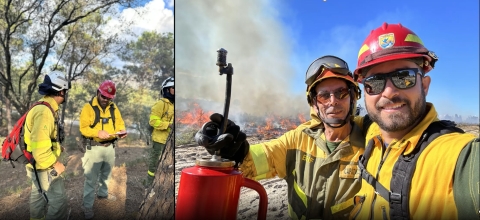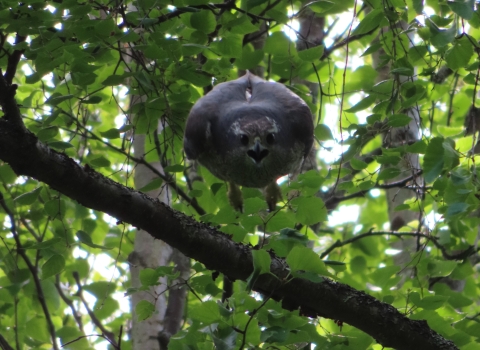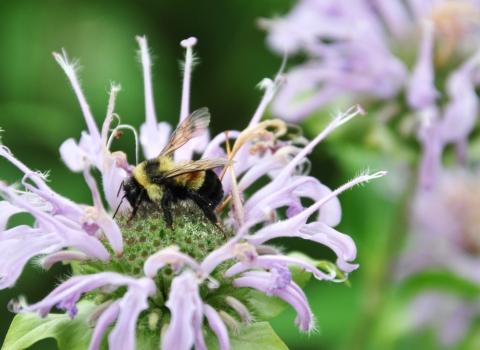In late fall 2022, Jose Palacios and Jaime Rodriguez, U.S. Fish and Wildlife Service wildland firefighters from Sacramento National Wildlife Refuge Complex in California, attended the Andalucía Prescribed Fire Training Exchange (TREX) in southern Spain. Jaime, an Engine Captain, and Jose, a Fire Engine Operator, are part of the fire management zone that serves refuges in California’s North Central Valley.
TREX is an innovative experiential training program developed by The Nature Conservancy and hosted worldwide. Its goal is to facilitate the exchange of knowledge and skills to build local capacity for successful prescribed fire programs around the globe.
The 2022 Andalucía TREX was the second event to be held in Spain. The objective was to continue building upon Spain’s growing prescribed fire program. Spain, like the U.S., is experiencing an increase in wildfire frequency and severity. Prescribed burning is a tool land managers use to reduce hazardous fuel loading and to minimize the spread and potential impacts of wildfire. Additionally, prescribed burning is a highly effective management tool USFWS uses to improve wildlife habitat and restore natural processes.
For this training event, the cadre spent three weeks learning together, sharing information, and applying their skills during prescribed burns across the region of Andalucía. The team was composed of about 60 participants, with most from Spain, a cohort from Portugal, and nine individuals from the United States.
Jose and Jaime were assigned as task book evaluators for several operational positions specific to prescribed fire. Andalucía’s fire management agency has adopted the U.S. wildland fire position task book system. Position task books provide a standard, measurable way to evaluate the ability of a firefighter as they work to gain new fire qualifications. Jose is a qualified Firing Boss. A Firing Boss leads and coordinates ignition operations during a prescribed burn prescribed burn
A prescribed burn is the controlled use of fire to restore wildlife habitat, reduce wildfire risk, or achieve other habitat management goals. We have been using prescribed burn techniques to improve species habitat since the 1930s.
Learn more about prescribed burn . Jaime is a qualified Burn Boss, whose job is to ensure all prescribed fire plan specifications are met before, during, and after a prescribed fire. During TREX, Jaime and Jose evaluated their trainees’ proficiency and provided constructive feedback.
During the cadre’s first ignition, Jaime saw some strategic adjustments that could improve the burn pattern — how the fire moves across the landscape. He paused the operation and introduced the group to how igniting the vegetation in various ways, called firing technique, results in different fire effects.
“Providing teachable moments, like these, is one of the foundations of the TREX program – to exchange information and knowledge, and ultimately increase proactive fire management,” said Jose.
While the cadre consisted of experienced firefighters, many had not used fire as a management tool. Because of this, Jose and Jaime were some of the most experienced prescribed fire practitioners in the group.
Among the Department of the Interior agencies, USFWS applies approximately 50% of all prescribed fire acres across the country, providing ample opportunity for employees to practice their skills and knowledge. Jaime and Jose noted that being a part of a small and nimble, resource focused agency allows them to build a diverse fire management skillset, while also encouraging their development into leadership roles.
What may have best prepared the California firefighters to engage and share their knowledge, however, was a tool not found in their fire packs. That tool was their Spanish language fluency. Jaime and Jose credit their language fluency for allowing a full, immersive experience— not only could they translate questions and tackle the technical discussions of firing operations, but they could joke, laugh, and build comradery with their international crew.
Using prescribed fire to minimize the impacts of wildfire is a relatively new approach for Spain. This unfamiliar method of land management drew in curious and skeptical spectators. One such group, Andalucía’s hunting clubs, a majority landowner in the region, was initially skeptical of prescribed fire as a management tool. After the burns, Jaime observed a shift among the crowd as they started to see the potential and benefits of prescribed fire on the landscape.
“It was obvious to me, and everyone involved with that particular prescribed fire, those skeptical individuals became more open to discussing the potential benefits of prescribed fire,” said Jaime. “I really feel like we changed minds that day.”
The TREX program is lighting the way for conversations about best practices and lessons learned between communities and countries. Jose and Jaime reflect on their journey to Andalucía as an opportunity of a lifetime; but perhaps it is just the beginning to an ongoing dialogue between fire practitioners and wildlife advocates around the globe.



